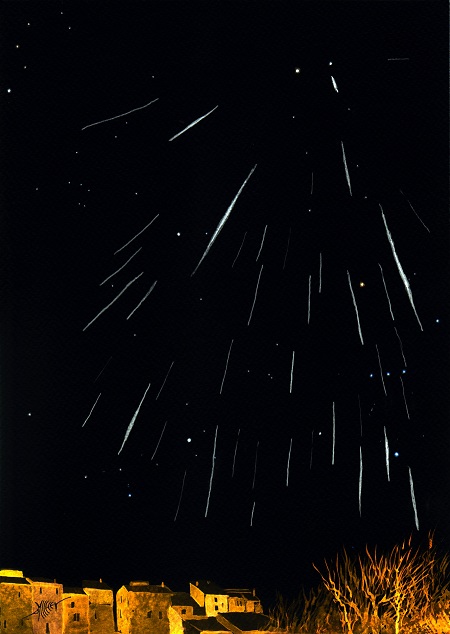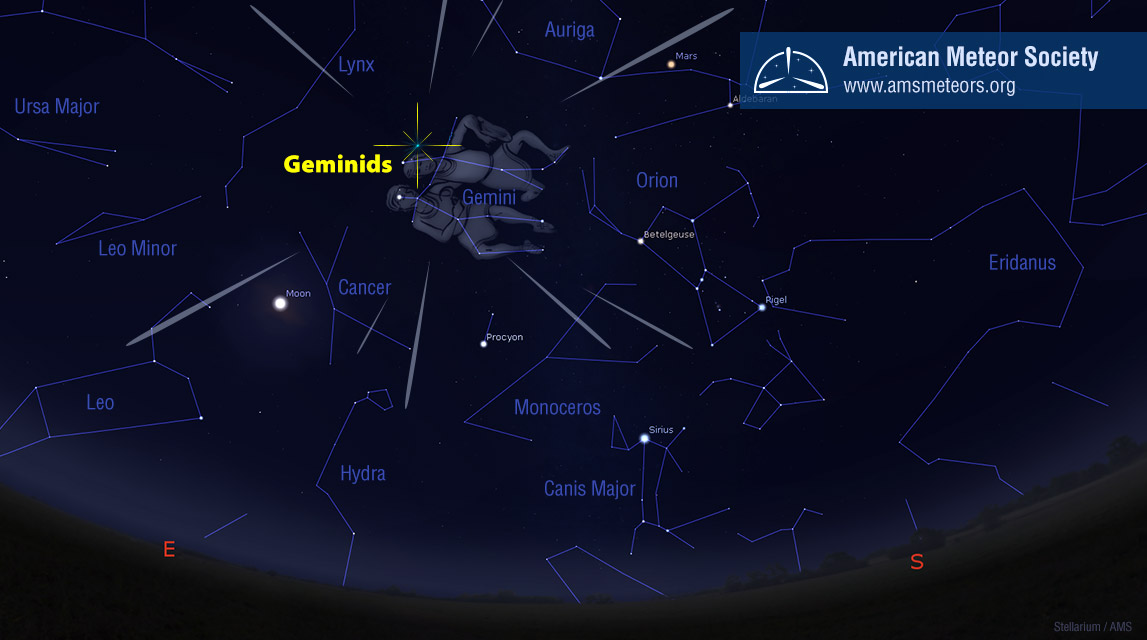
The most dependable meteor shower
Year in and year out the Geminids are currently the most dependable meteor shower. Unfortunately, they are active in December when temperatures are often cold and skies cloudy in the Northern Hemisphere. Then is this display worth viewing this year? Most certainly, but this year will be compromised with a bright waning gibbous moon that will rise near 10pm local standard time for most locations. Many meteors can still be seen, but it will be more of a challenge than usual.
Unlike most other meteor showers, the Geminids are not associated with a comet but with an asteroid. 3200 Phaethon is an asteroid with an orbit that brings it closer to the Sun than any other named asteroid (though there are numerous unnamed asteroids with smaller perihelia*). For this reason, it was named after the Greek myth of Phaëthon, son of the sun god Helios. Even though 3200 Phaethon is classified as an asteroid, it often acts like a comet by ejecting dust when it nears the sun. The Earth is near the orbit of 3200 Phaethon during the first three weeks of December. It comes closest to the core of the orbit on December 14th each year. This is the date most Geminid meteors are encountered and seen. When the Earth is near the edge of the orbital debris of the asteroid, little activity is seen.
* The perihelia is the point in a solar orbit where the orbiting body is closest to the sun.
So when and where do I look?
The Geminids are expected to be active between November 19th and December 24th this year. The shower does not kick into high gear until about December 10th, when hourly rates seen during the morning hours reach double digits. The highest rates are expected to occur on the night of December 13/14, when rates can approach one per minute during the morning hours from dark sky sites on moonless nights.Those rates will be difficult to achieve this year as the bright moon will obscure all but the brighter meteors. A good strategy this year may be to observe between dusk and moon rise on the evening of December 13th. Rates are lower at this time of night as the Geminid radiant (the area of the sky Geminid meteors seem to shoot from) lies closer to the horizon. Therefore most of the meteors heading downward will be obscured by the horizon. The advantages of observing at this time of night will be the lack of moonlight, which will allow you to see faint Geminids, which make up the bulk of the meteors seen. Geminids seen during the early evening hours cannot penetrate deep into the atmosphere, therefore they last longer and create longer streaks in the sky. These “Earthgrazers” are best seen as soon as it becomes dark. If you are facing east toward Gemini, these are usually seen low in the northern sky moving right to left or low in the southern sky moving left to right. The reason for this is that the lower portions of the sky near the horizon contains a thicker slice of atmosphere. Therefore more meteors will be seen there. If you are lucky, you just may see a Earthgrazer shoot overhead, stretching nearly horizon to horizon. If your weather appears to be overcast on the peak night, you can try again during the evening hours on December 14th and 15th. Rates will fall by about 50 percent each night, but this is still stronger than most other nights of the year. An added bonus is that the moon will rise approximately 30 minutes later each successive night, therefore dark skies will last longer.

The radiant lies in the constellation of Gemini near the bright star known as Castor (alpha Geminorum). The radiant is not the actual source of the meteors. This artificial point in the sky, as well as the stars of Gemini, happen to lie in the background while the stream of Geminid meteors enter the atmosphere, seemingly from the radiant in the constellation of Gemini. The radiant point and the constellation of Gemini serves as a useful guide to identifying Geminids as not all meteors seen in December are Geminids. There are several other minor showers radiating from the constellations of Orion, Monoceros, Hydra, and Leo Minor, to name a few. There are also random meteors that appear from all over the sky. These meteors once belonged to their own meteor shower, but time has dispersed them to the point that a connection with other meteors is now impossible. On the night of maximum activity, the Geminids will provide over 90 percent of the meteor activity during the night. As you move away from the peak night this percentage falls drastically. These meteors are also seen in the Southern Hemisphere, but only during the middle of the night and at a reduced rate.
Geminid meteors can appear in any part of the sky. You do not have to face the constellation of Gemini to see them. It does help to have the radiant somewhere within your field of view. This will help in the identification of each meteor. Geminid meteors will shoot outward from the radiant while others will have random paths and speeds. Geminid meteors will appear slowest and shortest near the radiant. This is due to foreshortening as the meteors seen close to the radiant are moving in a direction toward you. Geminid meteors will appear fastest and longest at a point 90 degrees away from the radiant. Beyond 90 degrees distant from the radiant, the meteors will begin to slow and become shorter again. The Geminids enter the atmosphere at 21 miles per second, which is a medium velocity for meteors. Most Geminids will still last less than one second as they streak through the sky. This is slower than the recent Leonids, but faster than the Taurids of October and November. Fragmentation and persistent trains are rare for Geminids. The brighter Geminids can possess any color, but the brightest ones tend to be green.
Don’t go outside and stand to try and view the Geminid activity. Your neck will quickly stiffen and you will soon tire. I suggest using a comfortable lounge chair that allows you to look half-way up in the sky comfortably. Bring plenty of blankets to keep warm. Those who wish to contribute meteor counts should watch for at least one hour. The reason for this is that meteoroids are distributed randomly in outer space. When quoted hourly rates are 60, this does not mean you will see one meteor every minute. There will be 5 to 10 minute periods when little activity is evident. There will also be periods of similar length when there will be continuous activity of 3-4 meteors per minute. There are several “peaks” and “valleys” of meteor activity each hour so if you only watch for a short time, you may find yourself viewing during one of the lulls of activity.
This year serious observers can help us determine the effect that bright moonlight has upon observers of meteor activity. The International Meteor Organization is conducting a project for observers who view under bright moonlight during the Geminid meteor shower. You simply need to view for at least one hour and estimate your limiting magnitude every 30 minutes. This is easily done by counting the number of stars visible with certain areas of the sky. Charts for these areas are available at: https://www.imo.net/observations/methods/visual-observation/major/observation/#table1. Area 7 on chart #1 would be the easiest to use. Using more than one area is also encouraged to provide more estimates. Of course these limiting magnitude estimates can be attempted at all hours of the night, whether the moon is visible or not. You should expect to achieve better results (higher magnitude estimates) when the moon is below the horizon. The conversion table is available in Table 2 on the link provided above. Helpful tips for visual observing are also available at: https://www.imo.net/observations/methods/visual-observation/ and https://www.imo.net/observations/methods/visual-observation/major/observation/. In order to submit your observations we suggest that you fill out a visual meteor report form provided by the International Meteor Organization. You must register to provide your data, but there is a free option for those not wishing to subscribe to the IMO Journal. The AMS also accepts observations emailed directly to: Robert Lunsford
After two years of interfering moonlight, conditions for the 2023 Geminids are close to perfect with the new moon occurring on December 12th.
We wish you good luck and look forward to seeing your viewing results!
 American Meteor Society
American Meteor Society
I saw a huge light with tailbacks morning. Looking east it appears to have been traveling south. I have a short video.
An you show it to me? I’m in NJ and saw fire in the sky. Also things shook. They are saying sonic boom but that’s not fire.
Is your video posted somewhere? Love to see it.
Can u post th video
I live in Belgium. When is the best time to see the meteor shower tonight? Sadly it’s cloudy….
How about something simple, like “ look ESE from 10pm to 1am EST approximately 35 degrees above the horizon for your best chance of viewing the meteor shower…”. Instead of a graduate level astronomy lectire?